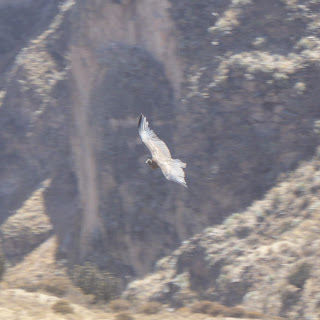For more of these costume statues, please see the album here.
Much of the lower canyon (more suitable for agriculture) is terraced to the extreme, and has been for over a thousand years. I hadn't seen such extended areas terraced before and the scale of it all was quite impressive.
The primary reason for visiting Colca was the opportunity to see Andean Condors. They live in the canyon, and can regularly be seen riding the early morning thermals on their way out for the day's hunting. We drove down to Condor Cross early and crossed our fingers we would see some.
Luck was with us, and we saw one in about 10 minutes, unfortunately it was rather far away.
After about half an hour or waiting and watching, we started to walk along the canyon to see a bit of it, and hopefully some more condors. What we did see was some humming birds. Enormous humming birds. Really huge, they must have been the size of UK blackbirds, but still doing the whole hovery thing.
 |
| The flowers the hummingbirds go for. The heads are about 1-2 feet long |
There were some pretty cacti, and a nice view of the busy touristy bit we had started at, now covered in tourists.
We also got to see up close some cochineal insects feeding on cacti. They don't look like much, in fact it just looks a bit moldy, but the insects are vitally important source of many different dyes that have traditionally been used in the Andes for a long time. When dried, crushed and mixed with different plants they produce a stunning variety of different colours. I don't understand the chemistry of it, but it's bound to be pretty complex!
Just when we thought we were done and were about to head back to the bus, another 2 condors came for a flypast! These were juveniles, but came really, really close (about 10-20 feet away) as they had a nosey.
The drive back to Arequipa after was fairly uneventful, but we did spot some wildlife. Some Andean ducks, 2 flamingos and some more alpacas, llamas and vicuna.
During our travels, we had seen many people, particularly ladies, dressed up in 'traditional dress', most of them selling tat to tourists. That makes me uncomfortable, both the tat selling and the traditional dress just for tourists, and I have avoided taking photos of them, partly because I feel it's rather fake, and partly because I'm not prepared to have the discussion about giving them a tip for taking photos of them. I did find one group in Colca that I was happy to take a photo of, and it kinda is traditional dress!






























































